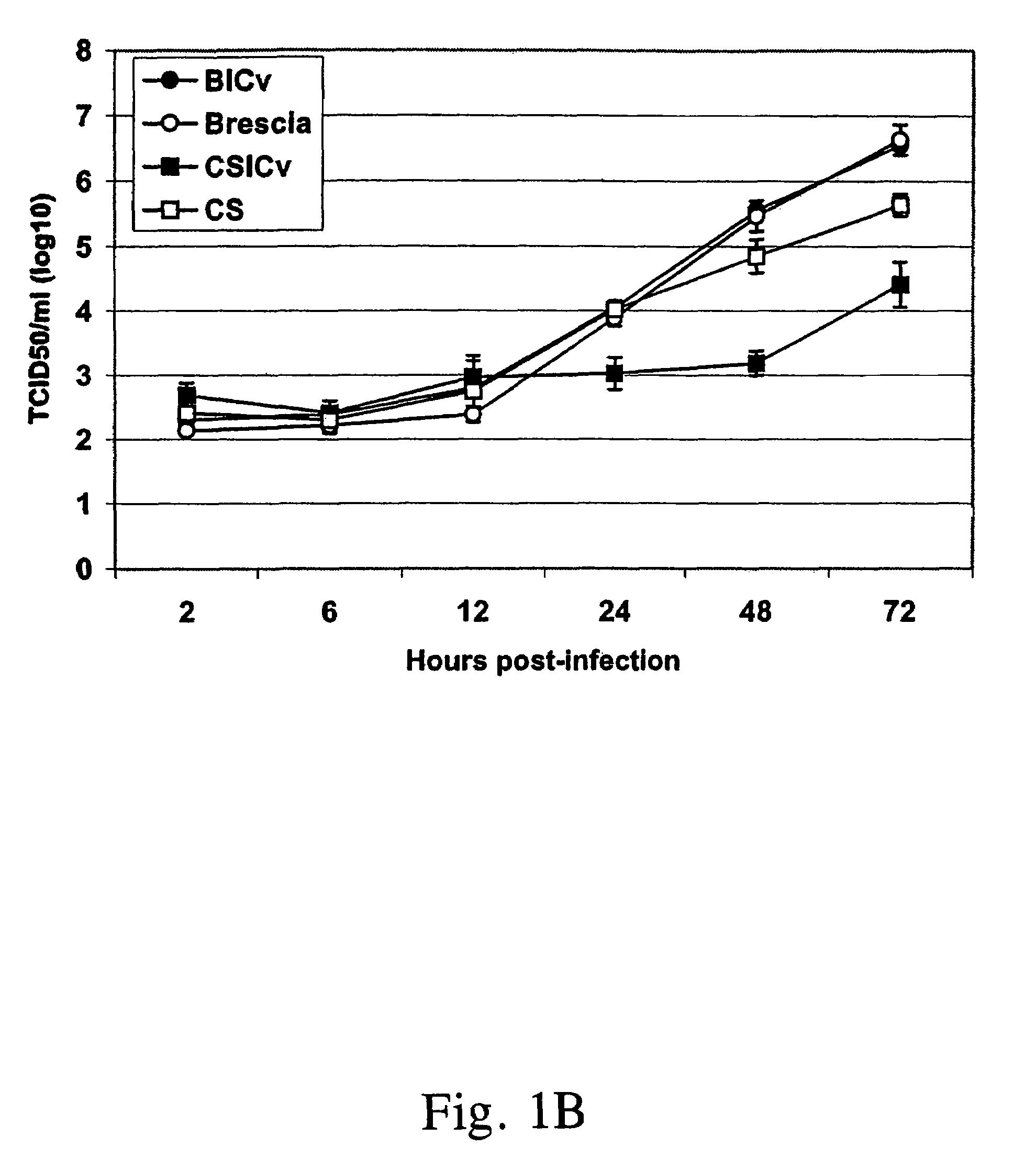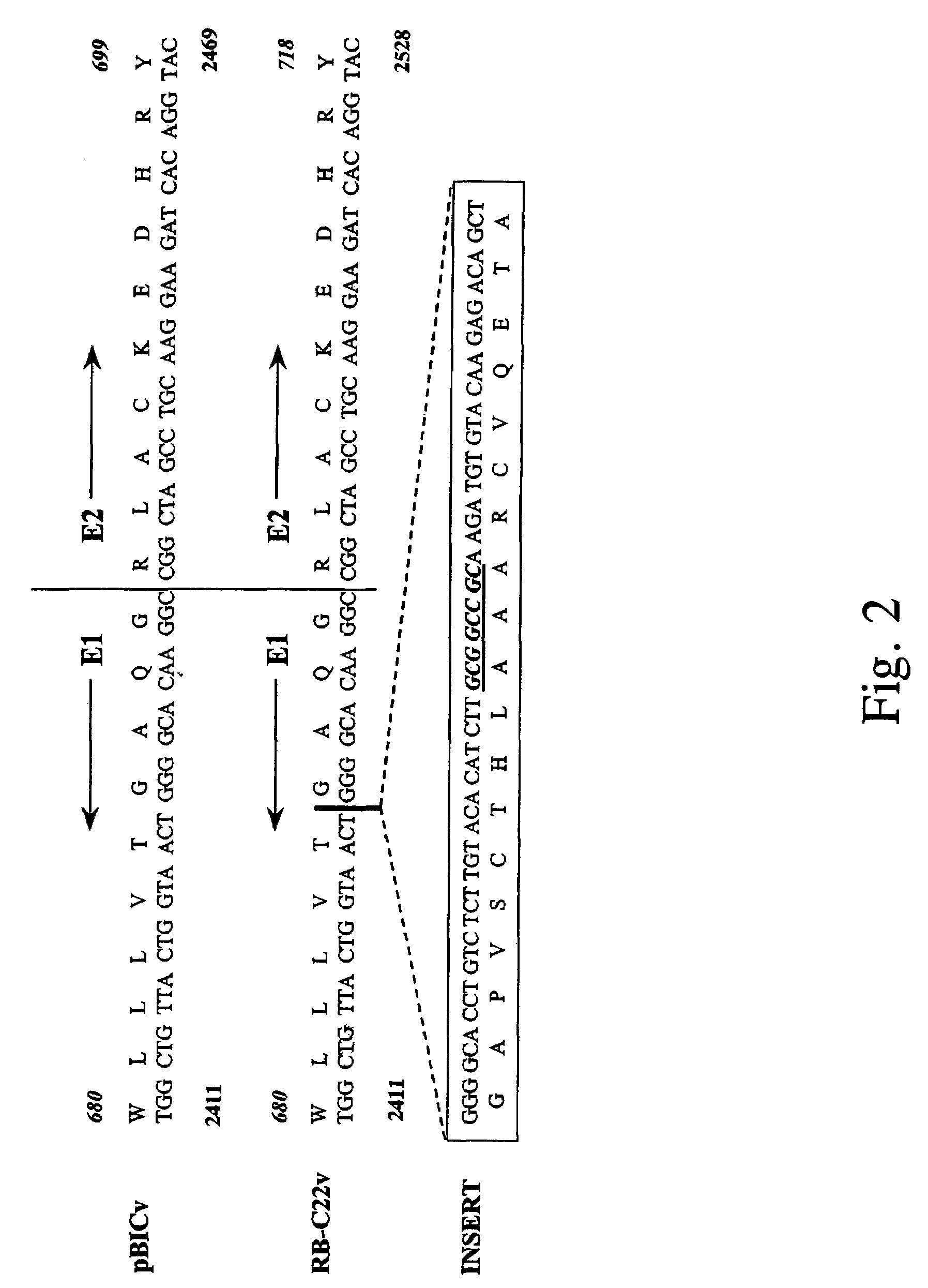Classical swine fever virus virulence determinant and a novel classical swine fever vaccine
a virulence determinant and vaccine technology, applied in the field of classical swine fever virus virulence determinant and novel classical swine fever vaccine, can solve the problems of large animal population, significant economic loss, and inability to distinguish between animals, serologically
- Summary
- Abstract
- Description
- Claims
- Application Information
AI Technical Summary
Benefits of technology
Problems solved by technology
Method used
Image
Examples
example 1
Viruses and Cell Cultures
[0053]Swine kidney cells (SK6) (Terpstra et al. 1990. Dtsch Tierarztl Wochenschr 97: 77-79) and free Bovine Viral Diarrhea Virus (BVDV) were used throughout this study. SK6 cells were cultured in Dulbecco's Minimal Essential Medium (DMEM, GIBCO, Grand Island, N.Y.) with 10% fetal calf serum (FCS, Atlas Biologicals, Fort Collins, Colo.). CSFV Brescia strain (obtained from the Animal and Plant Health Inspection Service, Plum Island Animal Disease Center) was propagated in SK6 cells and used for infectious cDNA clone construction. The CS vaccine strain is derived from the LK VNIIVIM parental vaccine strain by serial passages and cloning (Zaberezhny et al., supra). Titrations of CSFV from clinical samples were conducted in 96 well plates (Costar, Cambridge, Mass.) using SK6 cells. After 4 days in culture, viral infectivity was detected by immunoperoxidase assay using the CSFV monoclonal antibody 303 (Edwards et al. 1991. Vet. Microbiol. 29: 101-108) and the Vect...
example 2
Construction of CSFV Brescia pBIC, E1 Mutant RB-C22, E2 CS pCSIC and Chimeric Full-Length cDNA Infectious Clones
[0054]Total cellular RNA was obtained from SK6 cells (TRIzol method, Gibco) infected with peripheral blood obtained from pigs infected with CSFV strain Brescia or vaccine strain CS. cDNA spanning the entire genome of CSFV Brescia and CS were obtained by reverse transcription (RT) as follows: the reaction [1 μl of MMLV RT buffer, 4 mM dNTPs, 10 pmoles of specific reverse primers R12292, R8538, and R4567 (Table 1), 2 μL of total RNA, and 5.3 μl of water was incubated at 70° C. for 5 min, cooled at room temperature for 20 min, and further incubated for 1 hr at 37° C. following addition of 2 units of MMLV RT (Stratagene, Cedar Creek, Tex.). The entire genome of both strains was PCR amplified in three overlapping fragments using specific primers (Table 1 and FIG. 1A).
[0055]Infectious RNA was in vitro transcribed from a full-length copy of CSFV strain Brescia or CS (FIG. 1A). cD...
example 3
Rescue of CSFV Brescia, BICv, CSICv, and Chimeras
[0064]Full-length genomic infectious clones were linearized with SrfI and in vitro transcribed using the T7 Megascript system (Ambion, Austin, Tex.). RNA products were precipitated with LiCl and transfected into SK6 cells by electroporation at 500 volts, 720 ohms, 100 watts with a BTX 630 electroporator (BTX, San Diego, Calif.). Cells were plated in 12 well plates and 25 cm2 flasks, and incubated for 4 days at 37° C. 5% CO2 atmosphere. Virus was detected by immunoperoxidase staining using a CSFV E2 specific monoclonal antibody (WH303). Stocks of rescued viruses were stored at −70° C. Insert location was confirmed by RT-PCR and sequence analysis.
PUM
| Property | Measurement | Unit |
|---|---|---|
| Mortality rate | aaaaa | aaaaa |
| Volume | aaaaa | aaaaa |
| Volume | aaaaa | aaaaa |
Abstract
Description
Claims
Application Information
 Login to View More
Login to View More - R&D
- Intellectual Property
- Life Sciences
- Materials
- Tech Scout
- Unparalleled Data Quality
- Higher Quality Content
- 60% Fewer Hallucinations
Browse by: Latest US Patents, China's latest patents, Technical Efficacy Thesaurus, Application Domain, Technology Topic, Popular Technical Reports.
© 2025 PatSnap. All rights reserved.Legal|Privacy policy|Modern Slavery Act Transparency Statement|Sitemap|About US| Contact US: help@patsnap.com



